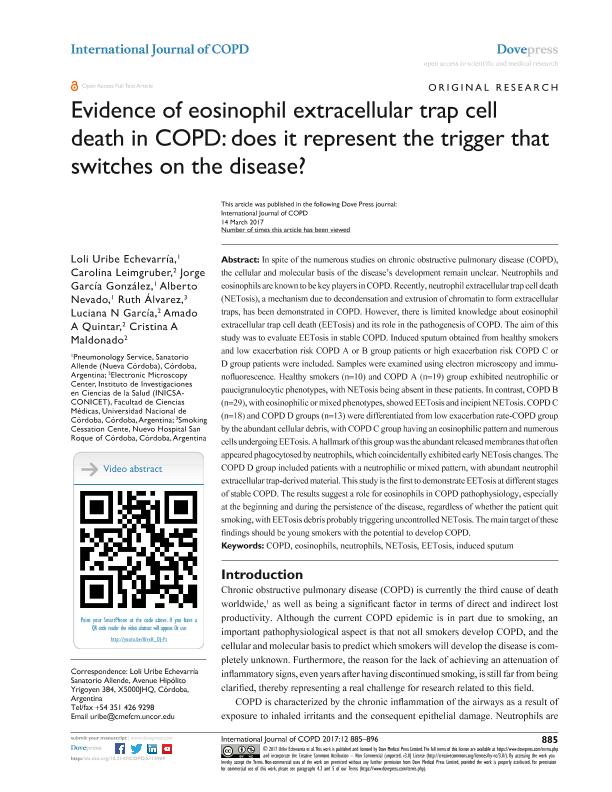Artículo
Evidence of eosinophil extracellular trap cell death in copd: Does it represent the trigger that switches on the disease?
Echevarría, Loli Uribe; Leimgruber, Carolina ; García González, Jorge; Nevado, Alberto; Álvarez, Ruth; García, Luciana Noemí
; García González, Jorge; Nevado, Alberto; Álvarez, Ruth; García, Luciana Noemí ; Quintar, Amado Alfredo
; Quintar, Amado Alfredo ; Maldonado, Cristina Alicia
; Maldonado, Cristina Alicia
 ; García González, Jorge; Nevado, Alberto; Álvarez, Ruth; García, Luciana Noemí
; García González, Jorge; Nevado, Alberto; Álvarez, Ruth; García, Luciana Noemí ; Quintar, Amado Alfredo
; Quintar, Amado Alfredo ; Maldonado, Cristina Alicia
; Maldonado, Cristina Alicia
Fecha de publicación:
03/2017
Editorial:
Dove Press
Revista:
International Journal of COPD
ISSN:
1178-2005
e-ISSN:
1176-9106
Idioma:
Inglés
Tipo de recurso:
Artículo publicado
Clasificación temática:
Resumen
In spite of the numerous studies on chronic obstructive pulmonary disease (COPD), the cellular and molecular basis of the disease’s development remain unclear. Neutrophils and eosinophils are known to be key players in COPD. Recently, neutrophil extracellular trap cell death (NETosis), a mechanism due to decondensation and extrusion of chromatin to form extracellular traps, has been demonstrated in COPD. However, there is limited knowledge about eosinophil extracellular trap cell death (EETosis) and its role in the pathogenesis of COPD. The aim of this study was to evaluate EETosis in stable COPD. Induced sputum obtained from healthy smokers and low exacerbation risk COPD A or B group patients or high exacerbation risk COPD C or D group patients were included. Samples were examined using electron microscopy and immunofluorescence. Healthy smokers (n=10) and COPD A (n=19) group exhibited neutrophilic or paucigranulocytic phenotypes, with NETosis being absent in these patients. In contrast, COPD B (n=29), with eosinophilic or mixed phenotypes, showed EETosis and incipient NETosis. COPD C (n=18) and COPD D groups (n=13) were differentiated from low exacerbation rate-COPD group by the abundant cellular debris, with COPD C group having an eosinophilic pattern and numerous cells undergoing EETosis. A hallmark of this group was the abundant released membranes that often appeared phagocytosed by neutrophils, which coincidentally exhibited early NETosis changes. The COPD D group included patients with a neutrophilic or mixed pattern, with abundant neutrophil extracellular trap-derived material. This study is the first to demonstrate EETosis at different stages of stable COPD. The results suggest a role for eosinophils in COPD pathophysiology, especially at the beginning and during the persistence of the disease, regardless of whether the patient quit smoking, with EETosis debris probably triggering uncontrolled NETosis. The main target of these findings should be young smokers with the potential to develop COPD.
Palabras clave:
Copd
,
Eetosis
,
Eosinophils
,
Induced Sputum
,
Netosis
,
Neutrophils
Archivos asociados
Licencia
Identificadores
Colecciones
Articulos(INICSA)
Articulos de INSTITUTO DE INVESTIGACIONES EN CIENCIAS DE LA SALUD
Articulos de INSTITUTO DE INVESTIGACIONES EN CIENCIAS DE LA SALUD
Citación
Echevarría, Loli Uribe; Leimgruber, Carolina; García González, Jorge; Nevado, Alberto; Álvarez, Ruth; et al.; Evidence of eosinophil extracellular trap cell death in copd: Does it represent the trigger that switches on the disease?; Dove Press; International Journal of COPD; 12; 3-2017; 885-896
Compartir
Altmétricas



